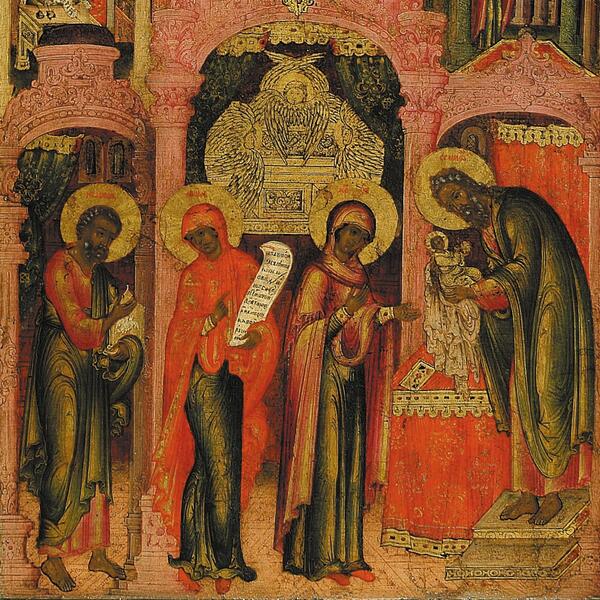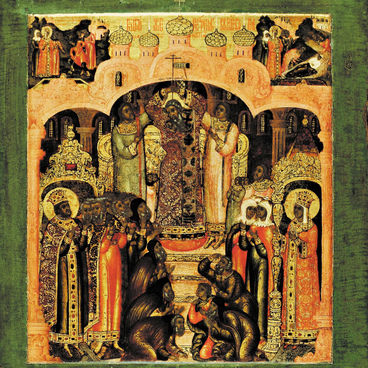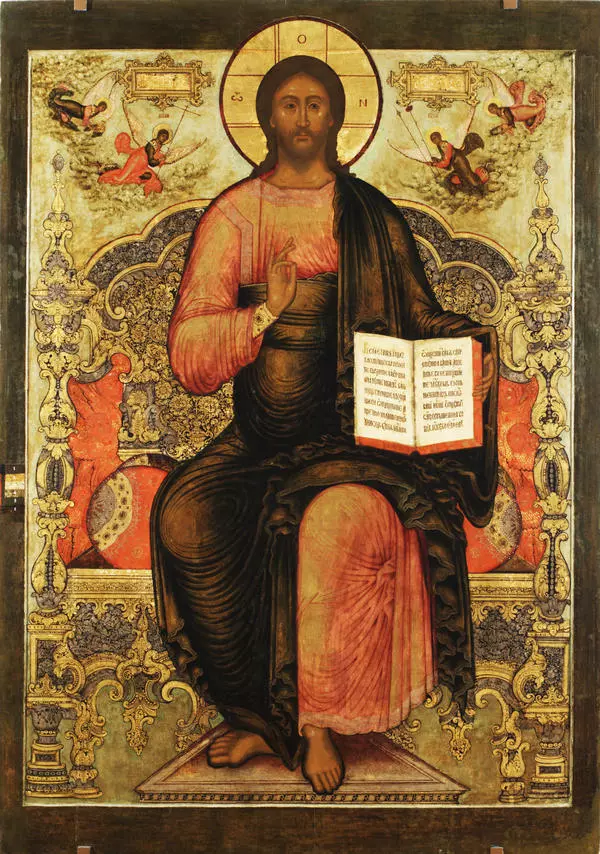This icon used to belong to the Feast tier of the iconostasis in the side altar of Barlaam of Khutyn, which was located at the Church of Elijah the Prophet. Most likely, the icon was painted by artists from the Brotherhood of Icon Painters under Gury Nikitin. The Presentation of Jesus Christ is described in detail by Saint Luke. Saint Joseph and the Virgin Mary brought their Child into the church for the first time where they were met by Simeon the God-Receiver and Anna the Prophetess.
The oldest known image of the Presentation of Jesus Christ, the mosaic created in 432–440, is located at the Basilica of Saint Mary Major in Rome. The first Russian fresco depicting this scene (1199) belongs to the Savior Church on Nereditsa Hill. The first icon is kept at the Novgorod Museum and dates back to the 14th century.
By the second half of the 17th century, the iconography of the image had been established. The icon depicts the interior of the church and the moment of the meeting. The composition is divided into two parts: the left one shows Righteous Joseph and Anna the Prophetess, and the right one portrays the Virgin Mary and Simeon the God-Receiver, taking the Child into his arms. The positions of figures with tilted heads and the color palette contribute to the symmetry of the image.
In his hands, Saint Joseph holds two pigeons (sometimes they were depicted in a cage, box, or basket) which represent the sacrifice in gratitude for the birth of their First-Born: one pigeon was intended for a burnt offering, and the other one — for a sin offering. Despite the Immaculate Conception, the Virgin Mary underwent an act of ritual purification to observe the Law.
In her hand, Anna the Prophetess holds a scroll — an attribute of prophets. According to Saint Luke, Anna became a widow at an early age and spent many years regularly practicing prayer and fasting. At the time she met Jesus, she was 84 years old (in the “Icon Painter’s Guide” by Viktor Fartusov, she is described as a slender 84-year-old woman), however, her age is not emphasized unlike that of Saint Simeon.
On the right, we can see that the Mother of God has given the Child to Simeon and lowered her head listening to the prophecy of the future Passion of Christ. The old man looks at the Child thoughtfully. The depiction of Christ combines the traits of a young child (the small figure in a white shirt) with the image of the Lord: in response to Simeon’s words “Lord, now lettest thou thy servant depart in peace”, he blesses the old man. Interestingly, the holy table, which is usually an important element of icons, is shown deep in the back and goes almost unnoticed behind the figures of the Mother and the God-Receiver, giving its place to the main scene of the icon.
The fine architectural details refer to Baroque motifs. The ornamental pattern blends seamlessly into the well-proportioned composition. The color palette consists mainly of light muted colors (ocher, red, golden, and green), reflecting the atmosphere of love and joy.
The oldest known image of the Presentation of Jesus Christ, the mosaic created in 432–440, is located at the Basilica of Saint Mary Major in Rome. The first Russian fresco depicting this scene (1199) belongs to the Savior Church on Nereditsa Hill. The first icon is kept at the Novgorod Museum and dates back to the 14th century.
By the second half of the 17th century, the iconography of the image had been established. The icon depicts the interior of the church and the moment of the meeting. The composition is divided into two parts: the left one shows Righteous Joseph and Anna the Prophetess, and the right one portrays the Virgin Mary and Simeon the God-Receiver, taking the Child into his arms. The positions of figures with tilted heads and the color palette contribute to the symmetry of the image.
In his hands, Saint Joseph holds two pigeons (sometimes they were depicted in a cage, box, or basket) which represent the sacrifice in gratitude for the birth of their First-Born: one pigeon was intended for a burnt offering, and the other one — for a sin offering. Despite the Immaculate Conception, the Virgin Mary underwent an act of ritual purification to observe the Law.
In her hand, Anna the Prophetess holds a scroll — an attribute of prophets. According to Saint Luke, Anna became a widow at an early age and spent many years regularly practicing prayer and fasting. At the time she met Jesus, she was 84 years old (in the “Icon Painter’s Guide” by Viktor Fartusov, she is described as a slender 84-year-old woman), however, her age is not emphasized unlike that of Saint Simeon.
On the right, we can see that the Mother of God has given the Child to Simeon and lowered her head listening to the prophecy of the future Passion of Christ. The old man looks at the Child thoughtfully. The depiction of Christ combines the traits of a young child (the small figure in a white shirt) with the image of the Lord: in response to Simeon’s words “Lord, now lettest thou thy servant depart in peace”, he blesses the old man. Interestingly, the holy table, which is usually an important element of icons, is shown deep in the back and goes almost unnoticed behind the figures of the Mother and the God-Receiver, giving its place to the main scene of the icon.
The fine architectural details refer to Baroque motifs. The ornamental pattern blends seamlessly into the well-proportioned composition. The color palette consists mainly of light muted colors (ocher, red, golden, and green), reflecting the atmosphere of love and joy.





